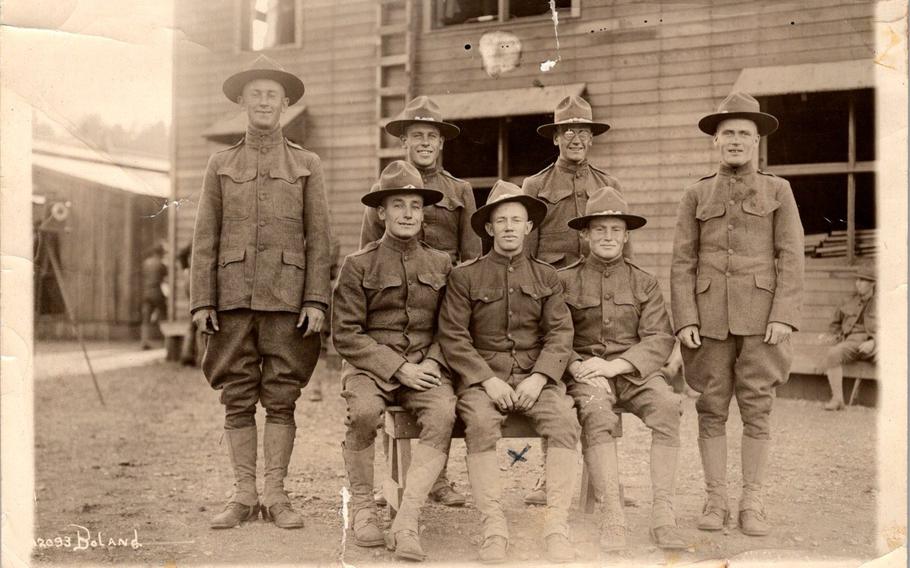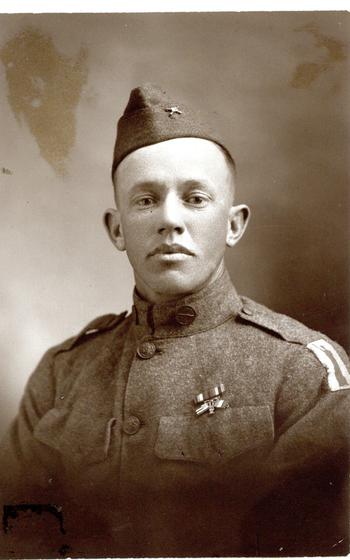
Pvt. Alonzo Stanton, center, was drafted into the Army at 22 years old and sent to France during World War I. He was wounded in combat on Oct. 14, 1918, during the Meuse-Argonne offensive. (Photo provided by Army Maj. Nate Olsen)
More than 100 years after being wounded in World War I’s largest battle, Pvt. Alonzo Stanton has finally been recognized with a Purple Heart.
“This award is not only for Uncle Lon, but it’s for all those who deserve a Purple Heart who may not…ever receive it,” Lon Bailey, Stanton’s nephew, said Sunday during the ceremony that was part of a patriotic celebration in Hyrum, Utah, a town of roughly 10,000 people that’s about 80 miles north of Salt Lake City.
The veteran’s 87-year-old nephew accepted the medal from Rep. Blake Moore, R-Utah, who worked with the family to get approval from the Army. Roughly 200 members of Stanton’s extended family gathered to mark the event.
Stanton, a Utah native, was part of the 77th Infantry Division and fought in the Meuse-Argonne offensive, the largest operation of American forces during the war and one of the deadliest in American history.
He was drafted into the Army at 22 and was among more than 120,000 wounded troops in the battle, according to the National Archives. Another 26,000 died in combat of the more than one million Americans who fought in the battle.
Bailey got to know his uncle through the letters he sent home from the war, which he has carefully preserved over the decades.
Growing up on a farm, Stanton was in awe of the food at Camp Lewis, Wash., where he attended basic training. He wrote he couldn’t get enough of it, even requesting his mother have ice cream and cake ready for his return.
He noted to his parents other differences in Army life.
“I am feeling fine and getting along good with my work, [though] it is a different kind of work than I am used to doing,” Stanton wrote in September 1918. “I don’t want you to worry about me because I will be alright. I will take good care of myself because I think I have something to live for. I feel somewhat different than I did when I left home.”
Maj. Nate Olsen, an Army attorney at Fort Bliss, Texas, and Bailey’s great nephew, worked with Bailey to secure the Purple Heart, and said the letters brought Stanton to life for him and the experiences of the war.
“So much of his personality comes through in them. He missed his home and his farm. He worried about his father working too hard on the farm. He always told his mother not to worry about him because he was being ‘a good boy’ and would come home just as good as when he left. He very rarely mentioned fighting but would sometimes allude to having shells bursting over his head, having a good friend killed next to him as they went over the top, and seeing things that would ‘turn his blood green,’” Olsen said.
In France’s Argonne Forest, Stanton’s division spent nearly three weeks clearing the area of German units. By the time he was evacuated from combat with shrapnel in both legs, the division had advanced more than 13 miles through black forests and across a river valley of marsh and mud, according to the George S. Robb Centre for the Study of the Great War at Park University in Missouri.
When the war ended a month later, the 77th was the closest American division to the German frontier. Stanton marked the war’s end from an Army hospital and was formally discharged in May 1919.
Back in Hyrum — a town that Stanton’s grandparents had helped found about 80 years earlier — he married and returned to farming, growing barley, sugar beets and peaches. He died in a farming accident in 1936 at the age of 40 before he could have children.
The Purple Heart initially was not open to World War I veterans.
The award dates back to the Revolutionary War as the Badge of Military Merit and the only honor available to enlisted troops. It was made of purple cloth sewn in the shape of a heart, according to the Defense Department.
However, the award went dormant until 1932 when it was renamed and authorized for all soldiers wounded by the enemy. It took on its new name, the Purple Heart. It was made retroactively available to World War I veterans who had not yet been awarded one after Stanton’s death.
It never sat right with Bailey that his uncle had not received this recognition. He petitioned the Army for it in the 1980s but was rejected because he was not a direct relative of Stanton. One did not exist.
A couple of years ago, Bailey told Olsen about his failed attempt at the medal. Olsen had just come from an assignment at the Pentagon where he had worked on posthumous awards and decided to take on the effort. With a member of Congress supporting the award, he knew they could bypass the lack of direct relatives, he said.
“When the Olsen family reached out to my office about getting the Purple Heart for their great-uncle, we were thrilled to play a part in making this happen,” Moore said. “While posthumously awarding a Purple Heart for World War I service is exceptionally rare, Pvt. Stanton’s courage and sacrifice warranted nothing less and helps ensure his sacrifice isn’t forgotten in history.”
Stanton’s military uniform has been on display for decades at the Hyrum City Museum and the Purple Heart will now accompany it.
“It seemed to us that rather than have one family keep the actual Purple Heart medal, it would be more appropriate and better to have it in the museum along with his uniform, where it kind of belongs not only to the entire family, but to this particular community,” Olsen said.

Pvt. Alonzo Stanton was drafted into the Army at 22 years old and sent to France during World War I. He was wounded in combat Oct. 14, 1918, during the Meuse-Argonne Offensive. (Photo provided by Army Maj. Nate Olsen)